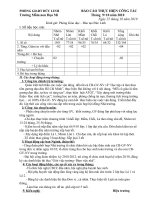baocao cdta
Bạn đang xem bản rút gọn của tài liệu. Xem và tải ngay bản đầy đủ của tài liệu tại đây (1.86 MB, 22 trang )
H SP TR NG THCS KIM NG CĐ ƯỜ Ọ
Trường THCS Kim Ngọc
Tổ khoa học xã hội
Nhóm Tiếng Anh
o0o
Báo cáo
chuyên đề
Ngày 16 tháng 10 năm 2008.
I.Introduction
Speaking is "the process of building and sharing meaning through
the use of verbal and non-verbal symbols, in a variety of contexts"
(Chaney, 1998, p. 13). Speaking is a crucial part of second
language learning and teaching. Despite its importance, for many
years, teaching speaking has been undervalued and English
language teachers have continued to teach speaking just as a
repetition of drills or memorization of dialogues. However, today's
world requires that the goal of teaching speaking should improve
students' communicative skills, because, only in that way, students
can express themselves and learn how to follow the social and
cultural rules appropriate in each communicative circumstance. In
order to teach second language learners how to speak in the best
way possible, some speaking activities are provided below, that can
be applied to ESL classroom settings, together with suggestions for
teachers who teach oral language.
What Is "Teaching Speaking"?
What is meant by "teaching speaking" is to teach ESL
learners to:
Produce the English speech sounds and sound patterns
Use word and sentence stress, intonation patterns and the
rhythm of the second language.
Select appropriate words and sentences according to the
proper social setting, audience, situation and subject matter.
Organize their thoughts in a meaningful and logical
sequence.
Use language as a means of expressing values and
judgments.
Use the language quickly and confidently with few unnatural
pauses, which is called as fluency.
How To Teach Speaking
Now many linguistics and teachers agree on that
students learn to speak in the second language by
"interacting". Communicative language teaching and
collaborative learning serve best for this aim.
Communicative language teaching is based on real-life
situations that require communication. By using this
method in classes, students will have the opportunity of
communicating with each other in the target language.
In brief, teachers should create a classroom environment
where students have real-life communication, authentic
activities, and meaningful tasks that promote oral
language. This can occur when students collaborate in
groups to achieve a goal or to complete a task.
II.Activities To Promote Speaking
Discussions
After a content-based lesson, a discussion can be held for various
reasons. The students may aim to arrive at a conclusion, share
ideas about an event, or find solutions in their discussion groups.
Before the discussion, it is essential that the purpose of the
discussion activity is set by the teacher. In this way, the discussion
points are relevant to this purpose, so that students do not spend
their time chatting with each other about irrelevant things. For
example, students can become involved in agree/disagree
discussions. In this type of discussions, the teacher can form
groups of students, preferably 4 or 5 in each group, and provide
controversial sentences like “people learn best when they read vs.
people learn best when they travel”. Then each group works on
their topic for a given time period, and presents their opinions to the
class. It is essential that the speaking should be equally divided
among group members.
At the end, the class decides on the winning group who
defended the idea in the best way. This activity fosters
critical thinking and quick decision making, and students
learn how to express and justify themselves in polite
ways while disagreeing with the others. For efficient
group discussions, it is always better not to form large
groups, because quiet students may avoid contributing
in large groups. The group members can be either
assigned by the teacher or the students may determine it
by themselves, but groups should be rearranged in
every discussion activity so that students can work with
various people and learn to be open to different ideas.
Lastly, in class or group discussions, whatever the aim
is, the students should always be encouraged to ask
questions, paraphrase ideas, express support, check for
clarification, and so on.
Role Play
One other way of getting students to speak is
role-playing. Students pretend they are in various
social contexts and have a variety of social roles.
In role-play activities, the teacher gives
information to the learners such as who they are
and what they think or feel. Thus, the teacher can
tell the student that "You are David, you go to the
doctor and tell him what happened last night,
and…"









